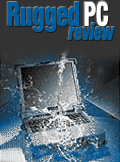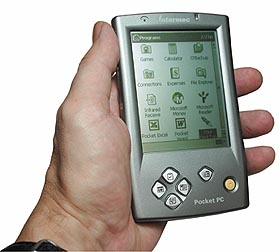

|
|
|
|
|
|
Intermec Model 70Speedy slimline monochrome Pocket PC (May 2001 issue) Every once
in a while even the intrepid editorial team here at Pen Computing Magazine gets
blind-sided by the introduction of a new device that we've never heard of. That's what happened when I ran into Intermec's Mike
Colwell at the recent Mobile Insights 2001 Conference in Phoenix, Arizona. Mike
asked me what I thought of their new Intermec Model 70. I first thought he was
referring to Intermec's ruggedized 700 Series of Pocket PCs, but when he casually
pulled out the Model 70 it was clearly a device I had not seen, nor heard of,
before. Its overall shape reminded me a bit of the old Philips Nino, the button
diamond on the front looked like that of earlier Everex models, and there was
also a bit of a resemblance to the now discontinued Compaq Aero 1550 Pocket PC.
Mike, never one to beat around the bush, revealed the Model 70's heritage with a
simple, "It's made by HTC." HTC, of course, happens to be the Taiwanese company
that made the Everex Freestyle, its Trogon cousins, all of Compaq's palm-size and
Pocket PCs, and a number of other PDA designs that never made it to the US
market. Mystery solved.
Why would Intermec introduce a device such as the Model 70? The answer is
simple. Though Intermec is engaged in vertical markets and most of its hardware
is rugged, the company recognized that a lot of its customers need inexpensive,
lightweight, non-rugged devices for use in trailers, field offices, and so on.
Those customers may feel more comfortable buying from a company they know and
trust rather than from, say, CompUSA. The Model 70 falls into this category.
Unlike the ruggedized Casio EG-80/800, and the even tougher Casio IT-70/700, the
Intermec Model 70 is basically just a standard consumer market Pocket PC. It
measures 3.1 x 5.1 x 0.5 inches--virtually identical to the now defunct Compaq
Aero 1550--and weighs just under six ounces. It is slimmer and lighter than most
PDAs and will fit anywhere.
A look inside the matte-gray plastic housing reveals the Intermec Model 70
as what might have been the next generation Compaq Aero 1550. In other words, but
for the intrigue of international OEM deals, this device--and not the iPAQ 3150 we
reviewed in our last issue--could have been the new monochrome PDA offering from
Compaq. The overall layout and design of the Model 70 motherboard and controls is
almost identical to that of the older Compaq Aero 1500 Series. Battery, CF card
slot, docking connector, and many other components of the devices are identically
placed. Some parts have been rearranged to make the newer device easier to
assemble. Backup battery and speaker locations, for example, have been switched
so that the backside of the new device no longer dangles by a speaker wire as the
old one did. Like the "Compaq," the new Intermec device has a removable
daughterboard with an Intel Flash ROM chip, making OS upgrades literally a snap.
I know this is likely more than you wanted to know about the innards of the Model
70, but for us it was nice to see how HTC used a successful existing design,
thought it through, and made it even better.
The big difference between the two is that the old Aero 1550 ran on a
rather anemic 70MHz NEC VR4111 CPU whereas the Intermec Model 70 is powered by a
206 MHz Intel StrongARM SA-1110 processor, the same as in the Compaq iPAQ and an
increasing number of new PDA designs. As a result, the Model 70's average
benchmarks are triple that of the Aero 1550 and generally on par with the iPAQ
3650. The Model 70 scored an impressive average of 54.89 SquareMark in bSQUARE's
Analyzer benchmark suite, just a hair short of the iPAQ's 55.46. Due to its
simpler graphics subsystem the Model 70 actually outperformed the iPAQ in the
Graphstone test, but that was offset by a lower Dhrystone (integer) performance.
What it amounts to is that the Intermec Model 70 is one of the quickest PDAs you
can buy at any price.
In terms of ergonomics, the Model 70 is a very handy device. Due to its
slimline design, it doesn't feel like a brick in your pocket. The slightly curved
Nino-esque body fits well into the palm of your hand. And unlike the iPAQ or the
HP Jornada 540 series, the Model 70 retains the traditional rocker and action
buttons along the left side of the device in addition to five application buttons
on the front. Four of the application buttons, arranged in a four-leaf clover
pattern, bring up Tasks, Contacts, Notes, and Calendar. A fifth button mimics a
desktop or notebook keyboard's "Windows" key and brings up the Start menu.
Interestingly, you can turn on the Model 70 with either a button on the left or a
yellow one on the front. The one on the front also turns on and off the back
light.
In the connectivity department, the model 70 has something that the mighty
iPAQ does not: a CompactFlash slot. This means that you do not need an optional
sleeve to use a CF Card modem, Ethernet adapter, or storage card. A big plus.
Don't plan on using an IMB MicroDrive or one of those high capacity Type II CF
cards, though. The Model 70, like the HP Jornada, can only accommodate standard
CF Cards and not the thicker Type II format. Connecting and synchronizing
with a desktop or notebook computer is either via the IR port located on the
right top of the device, or through the Model 70's dock. The dock itself
resembles that of the Compaq 1550 (which actually fits into the Model 70's dock).
It is well designed, cradles the Model 70 well, and always made a good, solid
connection. Our unit came with a serial connection. Intermec says that a USB
version of the dock is available as well.
Power is provided by a 700mAH Lithium-Ion battery. The old Aero 1500 was
supposed to run up to 14 hours on its 600mAH pack whereas I rarely get more than
six hours from the color iPAQ's 950mAH battery. Expect around 10 hours from the
70.
How about the screen? Once you get used to the lack of color the Model
70's monochrome screen is crisp and clear. It is okay indoors and very good
outdoors, but doesn't quite provide the contrast of class-leading mono screens
like, for example, that of the Palm V. The Palm's screen provides true black text
on very light-green background. The Model 70's screen is more like dark green
text over a light green background.
Overall, the Model 70 Pocket PC is a fast, handy (albeit pricey) Pocket PC
that once again demonstrates Intermec's willingness to tap a variety of Asian
vendors to bring its customers a wealth of different mobile computing devices
such as the Sharp-made Intermec 6642 Windows 98 pen tablet and the Intermec 6651
Windows CE Handheld PC. It will be of interest both to existing Intermec
customers as well as those in the market for a fast monochrome Pocket PC.
|
